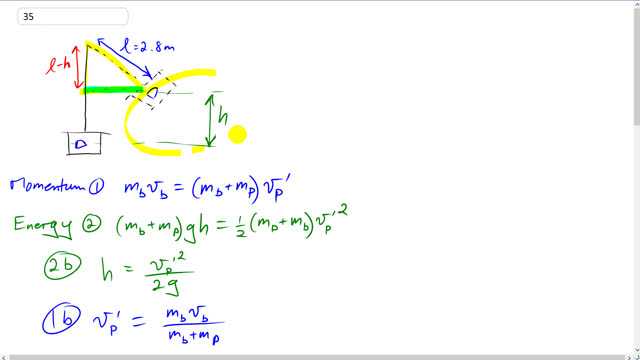
A 28-g rifle bullet traveling 190 m/s embeds itself in a 3.1-kg pendulum hanging on a 2.8-m-long string, which makes the pendulum swing upward in an arc. Determine the vertical and horizontal components of the pendulum’s maximum displacement.

In order to watch this solution you need to have a subscription.
This is Giancoli Answers with Mr. Dychko. We have to find the vertical and horizontal components of the displacement of this pendulum after the bullet embeds within it. So the height that it rises will be the vertical component of its displacement and we'll also figure out the horizontal part knowing that the length of the pendulum is 2.8 meters. So we'll end up with a triangle like this and we'll do some Pythagoras to figure out the length of this leg here. Now we know from conservation of momentum, this is during the moment where the bullet is just embedding within the block that the momentum of the bullet before it hits the block— mass of the bullet times velocity of the bullet— equals the mass of the bullet and pendulum combined times the velocity that the pendulum-bullet combination has immediately after the collision. So this is before it really starts moving just at that initial moment there and when it begins moving that's v P prime velocity of the pendulum after collision. And then we consider a second interval of time between when the pendulum starts here and rises up to here and during that time, energy is conserved even though energy is not conserved when I mean this is kinetic energy I'm talking about kinetic energy is not conserved when the bullet is embedding within the pendulum because it's an inelastic collision but momentum is conserved and so that's why we use the momentum formula's here. But after that's all taken care of and you know there's some heat energy lost and so on, after that's done and this pendulum starts to move freely then the only force involved is this conservative force of gravity and the mechanical energy is conserved. And so we have that the final kinetic energy that the bullet-pendulum combination has at this height, h, m b plus m P times gh is gonna equal the kinetic energy that the bullet and pendulum have after the bullet is fully embedded within the pendulum and that's gonna be one-half their combined mass times the v P prime squared. So we are trying to find out what h is and we know that h from this energy formula is gonna be the v P prime squared divided by 2g because the masses cancel here and divide both sides by g, you end up with this h equals v P prime squared over 2g and v P prime based on equation 1, we can divide both sides by m b plus m P and write this and switch the sides around and we get v P prime equals m bv b over the combined masses and then we'll substitute that into here for v P prime. And that's v P prime squared and so that's why we have this m bv b squared divided by 2g copied from the formula there times m b plus m P squared— this v b is the velocity of the bullet before it collides with the pendulum— and so the maximum height will be 0.028 times 190 meters per second and square that product and divide by 2 times 9.8 meters per second squared—acceleration due to gravity— times 0.028 kilograms plus 3.1 and square that sum and you get 0.1476 meters height. So according to this picture that is the vertical displacement so we'll say it's 0.15 meters, we'll round it to two significant figures; that's the vertical displacement of the pendulum. This is a right triangle so we'll say that the hypotenuse squared equals the l plus h leg squared plus the x-component of displacement squared. And so d x squared is gonna be l squared minus this bracket squared and then take the square root of both sides and you solve for d x. So d x is the square root of 2.8 squared minus 2.8 minus the vertical displacement h and then square that difference and you get 0.90 meters for the horizontal displacement of the pendulum.